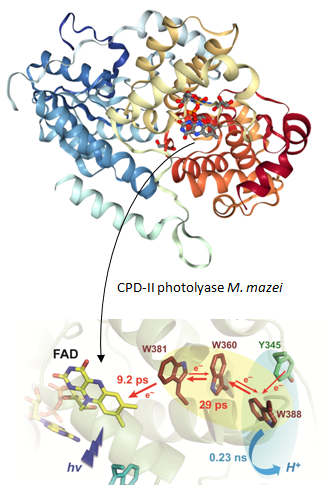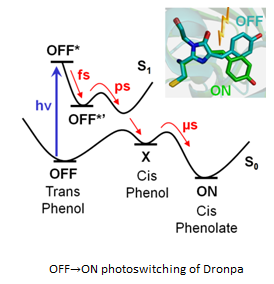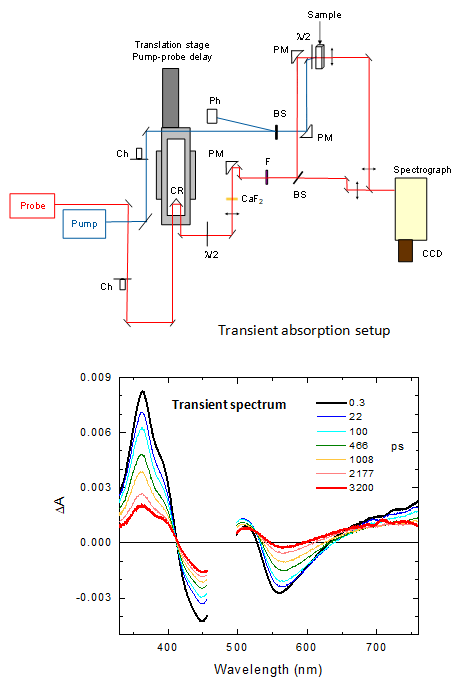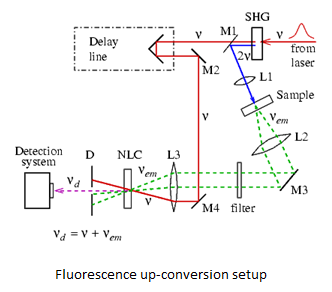2023
|
Multiscale Transient Absorption Study of the Fluorescent Protein Dreiklang and Two Point Variants Provides Insight into Photoswitching and Nonproductive Reaction Pathways Article de journal Emilie Renouard; Magdalena Nowinska; Fabien Lacombat; Pascal Plaza; Pavel Müller; Agathe Espagne The Journal of Physical Chemistry Letters, 14 (28), p. 6477-6485, 2023. @article{RN63c,
title = {Multiscale Transient Absorption Study of the Fluorescent Protein Dreiklang and Two Point Variants Provides Insight into Photoswitching and Nonproductive Reaction Pathways},
author = {Emilie Renouard and Magdalena Nowinska and Fabien Lacombat and Pascal Plaza and Pavel M\"{u}ller and Agathe Espagne},
url = {https://doi.org/10.1021/acs.jpclett.3c00431},
doi = {10.1021/acs.jpclett.3c00431},
year = {2023},
date = {2023-01-01},
journal = {The Journal of Physical Chemistry Letters},
volume = {14},
number = {28},
pages = {6477-6485},
keywords = {},
pubstate = {published},
tppubtype = {article}
}
|
Near-infrared co-illumination of fluorescent proteins reduces photobleaching and phototoxicity Article de journal L Ludvikova; E Simon; M Deygas; T Panier; M A Plamont; J Ollion; A Tebo; M Piel; L Jullien; L Robert; T Le Saux; A Espagne Nature Biotechnology, p. 12, 2023, ISSN: 1087-0156. @article{RN156,
title = {Near-infrared co-illumination of fluorescent proteins reduces photobleaching and phototoxicity},
author = {L Ludvikova and E Simon and M Deygas and T Panier and M A Plamont and J Ollion and A Tebo and M Piel and L Jullien and L Robert and T Le Saux and A Espagne},
url = {<Go to ISI>://WOS:001042699900001},
doi = {10.1038/s41587-023-01893-7},
issn = {1087-0156},
year = {2023},
date = {2023-01-01},
journal = {Nature Biotechnology},
pages = {12},
keywords = {},
pubstate = {published},
tppubtype = {article}
}
|
2021
|
Ultrafast Dynamics of Fully Reduced Flavin in Catalytic Structures of Thymidylate Synthase ThyX Article de journal Nadia Dozova; Fabien Lacombat; Murielle Lombard; Djemel Hamdane; Pascal Plaza Physical Chemistry Chemical Physics, 23 , p. 22692-22702, 2021, ISSN: 1463-9076. @article{RN123b,
title = {Ultrafast Dynamics of Fully Reduced Flavin in Catalytic Structures of Thymidylate Synthase ThyX},
author = {Nadia Dozova and Fabien Lacombat and Murielle Lombard and Djemel Hamdane and Pascal Plaza},
url = {http://dx.doi.org/10.1039/D1CP03379D},
doi = {10.1039/D1CP03379D},
issn = {1463-9076},
year = {2021},
date = {2021-01-01},
journal = {Physical Chemistry Chemical Physics},
volume = {23},
pages = {22692-22702},
keywords = {},
pubstate = {published},
tppubtype = {article}
}
|
Ultrafast photoreduction dynamics of a new class of CPD photolyases Article de journal Fabien Lacombat; Agathe Espagne; Nadia Dozova; Pascal Plaza; Pavel Müller; Hans-Joachim Emmerich; Martin Saft; Lars-Oliver Essen Photochemical & Photobiological Sciences, 20 (6), p. 733-746, 2021, ISSN: 1474-9092. @article{RN632,
title = {Ultrafast photoreduction dynamics of a new class of CPD photolyases},
author = {Fabien Lacombat and Agathe Espagne and Nadia Dozova and Pascal Plaza and Pavel M\"{u}ller and Hans-Joachim Emmerich and Martin Saft and Lars-Oliver Essen},
url = {https://doi.org/10.1007/s43630-021-00048-4},
doi = {10.1007/s43630-021-00048-4},
issn = {1474-9092},
year = {2021},
date = {2021-01-01},
journal = {Photochemical & Photobiological Sciences},
volume = {20},
number = {6},
pages = {733-746},
keywords = {},
pubstate = {published},
tppubtype = {article}
}
|
2020
|
Dynamic contrast for overcoming spectral interferences in fluorescence imaging Article de journal R Chouket; A Pellissier-Tanon; A Lemarchand; A Espagne; T Le Saux; L Jullien Journal of Physics-Photonics, 2 (3), p. 8, 2020, ISSN: 2515-7647. @article{RN1_30,
title = {Dynamic contrast for overcoming spectral interferences in fluorescence imaging},
author = {R Chouket and A Pellissier-Tanon and A Lemarchand and A Espagne and T Le Saux and L Jullien},
url = {<Go to ISI>://WOS:000572940200001},
doi = {10.1088/2515-7647/ab9099},
issn = {2515-7647},
year = {2020},
date = {2020-01-01},
journal = {Journal of Physics-Photonics},
volume = {2},
number = {3},
pages = {8},
keywords = {},
pubstate = {published},
tppubtype = {article}
}
|
Dynamic contrast with reversibly photoswitchable fluorescent labels for imaging living cells Article de journal R Chouket; A Pellissier-Tanon; A Lemarchand; A Espagne; T Le Saux; L Jullien Chemical Science, 11 (11), p. 2882-2887, 2020, ISSN: 2041-6520. @article{RN2x,
title = {Dynamic contrast with reversibly photoswitchable fluorescent labels for imaging living cells},
author = {R Chouket and A Pellissier-Tanon and A Lemarchand and A Espagne and T Le Saux and L Jullien},
url = {<Go to ISI>://WOS:000521247400002},
doi = {10.1039/d0sc00182a},
issn = {2041-6520},
year = {2020},
date = {2020-01-01},
journal = {Chemical Science},
volume = {11},
number = {11},
pages = {2882-2887},
keywords = {},
pubstate = {published},
tppubtype = {article}
}
|
2019
|
Photosensitized oxidative addition to gold(I) enables alkynylative cyclization of o-alkylnylphenols with iodoalkynes Article de journal Z H Xia; V Corce; F Zhao; C Przybylski; A Espagne; L Jullien; T Le Saux; Y Gimbert; H Dossmann; V Mouries-Mansuy; C Ollivier; L Fensterbank Nature Chemistry, 11 (9), p. 797-805, 2019, ISSN: 1755-4330. @article{RN3s,
title = {Photosensitized oxidative addition to gold(I) enables alkynylative cyclization of o-alkylnylphenols with iodoalkynes},
author = {Z H Xia and V Corce and F Zhao and C Przybylski and A Espagne and L Jullien and T Le Saux and Y Gimbert and H Dossmann and V Mouries-Mansuy and C Ollivier and L Fensterbank},
url = {<Go to ISI>://WOS:000483307000010},
doi = {10.1038/s41557-019-0295-9},
issn = {1755-4330},
year = {2019},
date = {2019-01-01},
journal = {Nature Chemistry},
volume = {11},
number = {9},
pages = {797-805},
keywords = {},
pubstate = {published},
tppubtype = {article}
}
|
Photosensitized oxidative addition to gold(i) enables alkynylative cyclization of o-alkylnylphenols with iodoalkynes Article de journal Zhonghua Xia; Vincent Corcé; Fen Zhao; Cédric Przybylski; Agathe Espagne; Ludovic Jullien; Thomas Le Saux; Yves Gimbert; Héloïse Dossmann; Virginie Mouriès-Mansuy; Cyril Ollivier; Louis Fensterbank Nature Chemistry, 11 (9), p. 797-805, 2019, ISSN: 1755-4349. @article{RN1_28,
title = {Photosensitized oxidative addition to gold(i) enables alkynylative cyclization of o-alkylnylphenols with iodoalkynes},
author = {Zhonghua Xia and Vincent Corc\'{e} and Fen Zhao and C\'{e}dric Przybylski and Agathe Espagne and Ludovic Jullien and Thomas Le Saux and Yves Gimbert and H\'{e}lo\"{i}se Dossmann and Virginie Mouri\`{e}s-Mansuy and Cyril Ollivier and Louis Fensterbank},
url = {https://doi.org/10.1038/s41557-019-0295-9},
doi = {10.1038/s41557-019-0295-9},
issn = {1755-4349},
year = {2019},
date = {2019-01-01},
journal = {Nature Chemistry},
volume = {11},
number = {9},
pages = {797-805},
keywords = {},
pubstate = {published},
tppubtype = {article}
}
|
Ultrafast Oxidation of a Tyrosine by Proton-Coupled Electron Transfer Promotes Light Activation of an Animal-like Cryptochrome Article de journal Fabien Lacombat; Agathe Espagne; Nadia Dozova; Pascal Plaza; Pavel Müller; Klaus Brettel; Sophie Franz-Badur; Lars-Oliver Essen Journal of the American Chemical Society, 141 (34), p. 13394-13409, 2019, ISSN: 0002-7863. @article{RN479,
title = {Ultrafast Oxidation of a Tyrosine by Proton-Coupled Electron Transfer Promotes Light Activation of an Animal-like Cryptochrome},
author = {Fabien Lacombat and Agathe Espagne and Nadia Dozova and Pascal Plaza and Pavel M\"{u}ller and Klaus Brettel and Sophie Franz-Badur and Lars-Oliver Essen},
url = {https://doi.org/10.1021/jacs.9b03680},
doi = {10.1021/jacs.9b03680},
issn = {0002-7863},
year = {2019},
date = {2019-01-01},
journal = {Journal of the American Chemical Society},
volume = {141},
number = {34},
pages = {13394-13409},
abstract = {The animal-like cryptochrome of Chlamydomonas reinhardtii (CraCRY) is a recently discovered photoreceptor that controls the transcriptional profile and sexual life cycle of this alga by both blue and red light. CraCRY has the uncommon feature of efficient formation and longevity of the semireduced neutral form of its FAD cofactor upon blue light illumination. Tyrosine Y373 plays a crucial role by elongating , as fourth member, the electron transfer (ET) chain found in most other cryptochromes and DNA photolyases, which comprises a conserved tryptophan triad. Here, we report the full mechanism of light-induced FADH• formation in CraCRY using transient absorption spectroscopy from hundreds of femtoseconds to seconds. Electron transfer starts from ultrafast reduction of excited FAD to FAD•\textendash by the proximal tryptophan (0.4 ps) and is followed by delocalized migration of the produced WH•+ radical along the tryptophan triad (∼4 and ∼50 ps). Oxidation of Y373 by coupled ET to WH•+ and deprotonation then proceeds in ∼800 ps, without any significant kinetic isotope effect, nor a pH effect between pH 6.5 and 9.0. The FAD•\textendash/Y373• pair is formed with high quantum yield (∼60%); its intrinsic decay by recombination is slow (∼50 ms), favoring reduction of Y373• by extrinsic agents and protonation of FAD•\textendash to form the long-lived, red-light absorbing FADH• species. Possible mechanisms of tyrosine oxidation by ultrafast proton-coupled ET in CraCRY, a process about 40 times faster than the archetypal tyrosine-Z oxidation in photosystem II, are discussed in detail.},
keywords = {},
pubstate = {published},
tppubtype = {article}
}
The animal-like cryptochrome of Chlamydomonas reinhardtii (CraCRY) is a recently discovered photoreceptor that controls the transcriptional profile and sexual life cycle of this alga by both blue and red light. CraCRY has the uncommon feature of efficient formation and longevity of the semireduced neutral form of its FAD cofactor upon blue light illumination. Tyrosine Y373 plays a crucial role by elongating , as fourth member, the electron transfer (ET) chain found in most other cryptochromes and DNA photolyases, which comprises a conserved tryptophan triad. Here, we report the full mechanism of light-induced FADH• formation in CraCRY using transient absorption spectroscopy from hundreds of femtoseconds to seconds. Electron transfer starts from ultrafast reduction of excited FAD to FAD•– by the proximal tryptophan (0.4 ps) and is followed by delocalized migration of the produced WH•+ radical along the tryptophan triad (∼4 and ∼50 ps). Oxidation of Y373 by coupled ET to WH•+ and deprotonation then proceeds in ∼800 ps, without any significant kinetic isotope effect, nor a pH effect between pH 6.5 and 9.0. The FAD•–/Y373• pair is formed with high quantum yield (∼60%); its intrinsic decay by recombination is slow (∼50 ms), favoring reduction of Y373• by extrinsic agents and protonation of FAD•– to form the long-lived, red-light absorbing FADH• species. Possible mechanisms of tyrosine oxidation by ultrafast proton-coupled ET in CraCRY, a process about 40 times faster than the archetypal tyrosine-Z oxidation in photosystem II, are discussed in detail. |
Ultrafast photoinduced flavin dynamics in the unusual active site of the tRNA methyltransferase TrmFO Article de journal N Dozova; F Lacombat; C Bou-Nader; D Hamdane; P Plaza Physical Chemistry Chemical Physics, 21 (17), p. 8743-8756, 2019, ISSN: 1463-9076. @article{RN115,
title = {Ultrafast photoinduced flavin dynamics in the unusual active site of the tRNA methyltransferase TrmFO},
author = {N Dozova and F Lacombat and C Bou-Nader and D Hamdane and P Plaza},
doi = {10.1039/c8cp06072j},
issn = {1463-9076},
year = {2019},
date = {2019-01-01},
journal = {Physical Chemistry Chemical Physics},
volume = {21},
number = {17},
pages = {8743-8756},
keywords = {},
pubstate = {published},
tppubtype = {article}
}
|
2018
|
A novel diarylethene-based photoswitchable chelator for reversible release and capture of Ca2+ in aqueous media Article de journal N Dozova; G Pousse; B Barnych; J -M Mallet; J Cossy; B Valeur; P Plaza Journal of Photochemistry and Photobiology A: Chemistry, 360 , p. 181–187, 2018. @article{Dozova:2018,
title = {A novel diarylethene-based photoswitchable chelator for reversible release and capture of Ca2+ in aqueous media},
author = {N Dozova and G Pousse and B Barnych and J -M Mallet and J Cossy and B Valeur and P Plaza},
url = {https://www.scopus.com/inward/record.uri?eid=2-s2.0-85046375200&doi=10.1016%2fj.jphotochem.2018.04.029&partnerID=40&md5=acfff9bc55e2d0bb41580e84374018fc},
doi = {10.1016/j.jphotochem.2018.04.029},
year = {2018},
date = {2018-01-01},
journal = {Journal of Photochemistry and Photobiology A: Chemistry},
volume = {360},
pages = {181--187},
abstract = {The synthesis and characterisation of a novel Reversibly Photoswitchable Chelator (RPC) of calcium ions, designed as a stepping stone towards producing pulses of calcium concentration in an aqueous environment, is reported. This RPC is constituted of a photochromic diarylethene core connected on one side to a BAPTA (1,2-bis(2-aminophenoxy)ethane-N,N,N’,N’-tetraacetic acid) calcium chelator and, on the other side, to an electron-withdrawing group. The operation principle consists in photoswitching on and off an intramolecular charge transfer between one nitrogen atom of the BAPTA moiety and the electron-withdrawing group, thereby modulating the chelating affinity of BAPTA for calcium ions. Solubility of the compound in a partially aqueous solvent was achieved by grafting a short PEG (polyethylene glycol) tail to the electron-withdrawing group. A reduction of the affinity for calcium ions upon photoswitching by a factor of 3\textendash4, in the hundred nM range of dissociation constant, is reported and constitutes a proof of concept of this type of RPC. © 2018 Elsevier B.V.},
keywords = {},
pubstate = {published},
tppubtype = {article}
}
The synthesis and characterisation of a novel Reversibly Photoswitchable Chelator (RPC) of calcium ions, designed as a stepping stone towards producing pulses of calcium concentration in an aqueous environment, is reported. This RPC is constituted of a photochromic diarylethene core connected on one side to a BAPTA (1,2-bis(2-aminophenoxy)ethane-N,N,N’,N’-tetraacetic acid) calcium chelator and, on the other side, to an electron-withdrawing group. The operation principle consists in photoswitching on and off an intramolecular charge transfer between one nitrogen atom of the BAPTA moiety and the electron-withdrawing group, thereby modulating the chelating affinity of BAPTA for calcium ions. Solubility of the compound in a partially aqueous solvent was achieved by grafting a short PEG (polyethylene glycol) tail to the electron-withdrawing group. A reduction of the affinity for calcium ions upon photoswitching by a factor of 3–4, in the hundred nM range of dissociation constant, is reported and constitutes a proof of concept of this type of RPC. © 2018 Elsevier B.V. |
Delocalized hole transport coupled to sub-ns tryptophanyl deprotonation promotes photoreduction of class II photolyases Article de journal F Lacombat; A Espagne; N Dozova; P Plaza; E Ignatz; S Kiontke; L O Essen Physical Chemistry Chemical Physics, 20 (39), p. 25446-25457, 2018, ISSN: 1463-9076. @article{RN114,
title = {Delocalized hole transport coupled to sub-ns tryptophanyl deprotonation promotes photoreduction of class II photolyases},
author = {F Lacombat and A Espagne and N Dozova and P Plaza and E Ignatz and S Kiontke and L O Essen},
url = {<Go to ISI>://WOS:000448345400028},
doi = {10.1039/c8cp04548h},
issn = {1463-9076},
year = {2018},
date = {2018-01-01},
journal = {Physical Chemistry Chemical Physics},
volume = {20},
number = {39},
pages = {25446-25457},
keywords = {},
pubstate = {published},
tppubtype = {article}
}
|
Macroscale fluorescence imaging against autofluorescence under ambient light Article de journal R Zhang; R Chouket; M -A Plamont; Z Kelemen; A Espagne; A G Tebo; A Gautier; L Gissot; J -D Faure; L Jullien; V Croquette; T Le Saux Light: Science and Applications, 7 (1), 2018. @article{Zhang:2018c,
title = {Macroscale fluorescence imaging against autofluorescence under ambient light},
author = {R Zhang and R Chouket and M -A Plamont and Z Kelemen and A Espagne and A G Tebo and A Gautier and L Gissot and J -D Faure and L Jullien and V Croquette and T Le Saux},
url = {https://www.scopus.com/inward/record.uri?eid=2-s2.0-85058077105&doi=10.1038%2fs41377-018-0098-6&partnerID=40&md5=958a21f219ba413e687d1860d21c2767},
doi = {10.1038/s41377-018-0098-6},
year = {2018},
date = {2018-01-01},
journal = {Light: Science and Applications},
volume = {7},
number = {1},
abstract = {Macroscale fluorescence imaging is increasingly used to observe biological samples. However, it may suffer from spectral interferences that originate from ambient light or autofluorescence of the sample or its support. In this manuscript, we built a simple and inexpensive fluorescence macroscope, which has been used to evaluate the performance of Speed OPIOM (Out of Phase Imaging after Optical Modulation), which is a reference-free dynamic contrast protocol, to selectively image reversibly photoswitchable fluorophores as labels against detrimental autofluorescence and ambient light. By tuning the intensity and radial frequency of the modulated illumination to the Speed OPIOM resonance and adopting a phase-sensitive detection scheme that ensures noise rejection, we enhanced the sensitivity and the signal-to-noise ratio for fluorescence detection in blot assays by factors of 50 and 10, respectively, over direct fluorescence observation under constant illumination. Then, we overcame the strong autofluorescence of growth media that are currently used in microbiology and realized multiplexed fluorescence observation of colonies of spectrally similar fluorescent bacteria with a unique configuration of excitation and emission wavelengths. Finally, we easily discriminated fluorescent labels from the autofluorescent and reflective background in labeled leaves, even under the interference of incident light at intensities that are comparable to sunlight. The proposed approach is expected to find multiple applications, from biological assays to outdoor observations, in fluorescence macroimaging. © 2018, The Author(s).},
keywords = {},
pubstate = {published},
tppubtype = {article}
}
Macroscale fluorescence imaging is increasingly used to observe biological samples. However, it may suffer from spectral interferences that originate from ambient light or autofluorescence of the sample or its support. In this manuscript, we built a simple and inexpensive fluorescence macroscope, which has been used to evaluate the performance of Speed OPIOM (Out of Phase Imaging after Optical Modulation), which is a reference-free dynamic contrast protocol, to selectively image reversibly photoswitchable fluorophores as labels against detrimental autofluorescence and ambient light. By tuning the intensity and radial frequency of the modulated illumination to the Speed OPIOM resonance and adopting a phase-sensitive detection scheme that ensures noise rejection, we enhanced the sensitivity and the signal-to-noise ratio for fluorescence detection in blot assays by factors of 50 and 10, respectively, over direct fluorescence observation under constant illumination. Then, we overcame the strong autofluorescence of growth media that are currently used in microbiology and realized multiplexed fluorescence observation of colonies of spectrally similar fluorescent bacteria with a unique configuration of excitation and emission wavelengths. Finally, we easily discriminated fluorescent labels from the autofluorescent and reflective background in labeled leaves, even under the interference of incident light at intensities that are comparable to sunlight. The proposed approach is expected to find multiple applications, from biological assays to outdoor observations, in fluorescence macroimaging. © 2018, The Author(s). |
2017
|
Loss of Fourth Electron-Transferring Tryptophan in Animal (6-4) Photolyase Impairs DNA Repair Activity in Bacterial Cells Article de journal J Yamamoto; K Shimizu; T Kanda; Y Hosokawa; S Iwai; P Plaza; P Müller Biochemistry, 56 (40), p. 5356–5364, 2017. @article{Yamamoto:2017,
title = {Loss of Fourth Electron-Transferring Tryptophan in Animal (6-4) Photolyase Impairs DNA Repair Activity in Bacterial Cells},
author = {J Yamamoto and K Shimizu and T Kanda and Y Hosokawa and S Iwai and P Plaza and P M\"{u}ller},
url = {https://www.scopus.com/inward/record.uri?eid=2-s2.0-85031007482&doi=10.1021%2facs.biochem.7b00366&partnerID=40&md5=ec7f70f4b2e5c57ef35f65a223a0f0ed},
doi = {10.1021/acs.biochem.7b00366},
year = {2017},
date = {2017-01-01},
journal = {Biochemistry},
volume = {56},
number = {40},
pages = {5356--5364},
abstract = {(6-4) photolyases [(6-4)PLs] are flavoproteins that use blue light to repair the ultraviolet-induced pyrimidine(6-4)pyrimidone photoproduct in DNA. Their flavin adenine dinucleotide (FAD) cofactor can be reduced to its repair-active FADH- form by a photoinduced electron transfer reaction. In animal (6-4)PLs, a chain of four Trp residues was suggested to be involved in a stepwise transfer of an oxidation hole from the flavin to the surface of the protein. Here, we investigated the effect of mutation of the fourth Trp on the DNA photorepair activity of Xenopus laevis (6-4)PL (Xl64) in bacterial cells. The photoreduction and photorepair properties of this mutant protein were independently characterized in vitro. Our results demonstrate that the mutation of the fourth Trp in Xl64 drastically impairs the DNA repair activity in cells and that this effect is due to the inhibition of the photoreduction process. We thereby show that the photoreductive formation of FADH- through the Trp tetrad is essential for the biological function of the animal (6-4)PL. The role of the Trp cascade, and of the fourth Trp in particular, is discussed. © 2017 American Chemical Society.},
keywords = {},
pubstate = {published},
tppubtype = {article}
}
(6-4) photolyases [(6-4)PLs] are flavoproteins that use blue light to repair the ultraviolet-induced pyrimidine(6-4)pyrimidone photoproduct in DNA. Their flavin adenine dinucleotide (FAD) cofactor can be reduced to its repair-active FADH- form by a photoinduced electron transfer reaction. In animal (6-4)PLs, a chain of four Trp residues was suggested to be involved in a stepwise transfer of an oxidation hole from the flavin to the surface of the protein. Here, we investigated the effect of mutation of the fourth Trp on the DNA photorepair activity of Xenopus laevis (6-4)PL (Xl64) in bacterial cells. The photoreduction and photorepair properties of this mutant protein were independently characterized in vitro. Our results demonstrate that the mutation of the fourth Trp in Xl64 drastically impairs the DNA repair activity in cells and that this effect is due to the inhibition of the photoreduction process. We thereby show that the photoreductive formation of FADH- through the Trp tetrad is essential for the biological function of the animal (6-4)PL. The role of the Trp cascade, and of the fourth Trp in particular, is discussed. © 2017 American Chemical Society. |
Photoinduced Chromophore Hydration in the Fluorescent Protein Dreiklang Is Triggered by Ultrafast Excited-State Proton Transfer Coupled to a Low-Frequency Vibration Article de journal F Lacombat; P Plaza; M -A Plamont; A Espagne Journal of Physical Chemistry Letters, 8 (7), p. 1489–1495, 2017. @article{Lacombat:2017,
title = {Photoinduced Chromophore Hydration in the Fluorescent Protein Dreiklang Is Triggered by Ultrafast Excited-State Proton Transfer Coupled to a Low-Frequency Vibration},
author = {F Lacombat and P Plaza and M -A Plamont and A Espagne},
url = {https://www.scopus.com/inward/record.uri?eid=2-s2.0-85017130354&doi=10.1021%2facs.jpclett.7b00348&partnerID=40&md5=dba41290a37553caaabb354a87ad0ec6},
doi = {10.1021/acs.jpclett.7b00348},
year = {2017},
date = {2017-01-01},
journal = {Journal of Physical Chemistry Letters},
volume = {8},
number = {7},
pages = {1489--1495},
abstract = {Because of growing applications in advanced fluorescence imaging, the mechanisms and dynamics of photoinduced reactions in reversibly photoswitchable fluorescent proteins are currently attracting much interest. We report the first time-resolved study of the photoswitching of Dreiklang, so far the only fluorescent protein to undergo reversible photoinduced chromophore hydration. Using broadband femtosecond transient absorption spectroscopy, we show that the reaction is triggered by an ultrafast deprotonation of the chromophore phenol group in the excited state in 100 fs. This primary step is accompanied by coherent oscillations that we assign to its coupling with a low-frequency mode, possibly a deformation of the chromophore hydrogen bond network. A ground-state intermediate is formed in the picosecond-nanosecond regime that we tentatively assign to the deprotonated water adduct. We suggest that proton ejection from the phenol group leads to a charge transfer from the phenol to the imidazolinone ring, which triggers imidazolinone protonation by nearby Glu222 and catalyzes the addition of the water molecule. © 2017 American Chemical Society.},
keywords = {},
pubstate = {published},
tppubtype = {article}
}
Because of growing applications in advanced fluorescence imaging, the mechanisms and dynamics of photoinduced reactions in reversibly photoswitchable fluorescent proteins are currently attracting much interest. We report the first time-resolved study of the photoswitching of Dreiklang, so far the only fluorescent protein to undergo reversible photoinduced chromophore hydration. Using broadband femtosecond transient absorption spectroscopy, we show that the reaction is triggered by an ultrafast deprotonation of the chromophore phenol group in the excited state in 100 fs. This primary step is accompanied by coherent oscillations that we assign to its coupling with a low-frequency mode, possibly a deformation of the chromophore hydrogen bond network. A ground-state intermediate is formed in the picosecond-nanosecond regime that we tentatively assign to the deprotonated water adduct. We suggest that proton ejection from the phenol group leads to a charge transfer from the phenol to the imidazolinone ring, which triggers imidazolinone protonation by nearby Glu222 and catalyzes the addition of the water molecule. © 2017 American Chemical Society. |




